Francis hailed as ‘a pope among people’ as world leaders join 200,000 mourners
Presidents, prime ministers and cardinals were among those bidding a final farewell to Pope Francis.

The “final image” of Pope Francis will be him greeting crowds on Easter Sunday despite “serious health problems”, the 200,000 people who gathered for his funeral in Vatican City were told.
Presidents, prime ministers and cardinals were among those bidding a final farewell to a religious leader described as “a pope among the people”, whose death sparked tributes from across the globe.
The 88-year-old, who died on Easter Monday, has been hailed for his leadership of the Church, proving popular among young people and known for his outreach to those most in need in society.
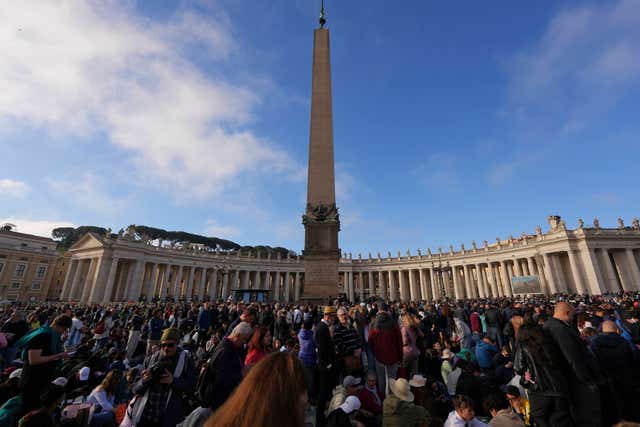
Addressing those gathered in St Peter’s Square on Saturday morning, Cardinal Giovanni Battista Re said: “The final image we have of him, which will remain etched in our memory, in our eyes and our hearts is that of last Sunday, Easter Sunday, when Pope Francis, despite his serious health problems, wanted to give us his blessings from the balcony of St Peter’s Basilica.
“He then came down to this square to greet from his open pope-mobile the large crowd gathered for the Easter mass.”
Cardinal Re also said the Pope “incessantly raised his voice” for peace and urged people to “build bridges not walls”.
US President Donald Trump joined UK Prime Minister Sir Keir Starmer and a host of other world leaders and dignitaries for the open-air funeral mass in St Peter’s Square.
Volodymyr Zelensky appeared to receive a round of applause as he stepped out of St Peter’s Basilica.

Mr Trump and Mr Zelensky met before the funeral and spoke about the war in Ukraine.
White House communications director Steven Cheung said the pair “had a very productive discussion”.
Mr Zelensky’s spokesman, Serhii Nykyforov, said the meeting lasted around 15 minutes.
A photograph of the two leaders shows them sitting opposite one another on chairs within St Peter’s Basilica, after both had paid their respects in front of the pontiff’s coffin.
The face-to-face meeting is the pair’s first since their tempestuous clash in the White House at the end of February.
The Vatican said 200,000 people attended the funeral.
Others who attended include the Prince of Wales – who attended on behalf of the King, Sir Keir and his wife Victoria, Foreign Secretary David Lammy, Irish President Michael D Higgins, Taoiseach Micheal Martin and Tanaiste Simon Harris, Scotland’s First Minister John Swinney and Michelle O’Neill, the First Minister of Northern Ireland.
Before the funeral William, side by side with Sir Keir, stood for a moment’s silence in front of Pope Francis’s sealed wooden and zinc coffin in its place before the altar in St Peter’s Basilica.
It is the first time the prince has represented the monarch at an international funeral.
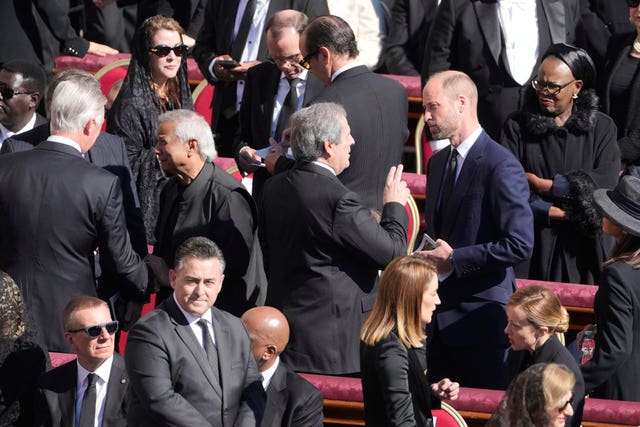
William spoke briefly to US President Donald Trump and first lady Melania Trump on his way into the service.
The seating plan was based on a complex order of precedence, with Argentina – the country of the Pope’s birth – and Italy at the front.
Other sovereigns, heads of state, and heads of government were then seated in alphabetical order of their countries’ names in the French language – used because French is considered the language of diplomacy.
Cardinal Re also told the crowd Pope Francis was “a pope among the people” who “truly shared the anxieties, sufferings and hopes of this time”.
The cardinal said: “He was a pope among the people, with an open heart towards everyone.
“He was also a pope attentive to the signs of the times and what the Holy Spirit was awakening in the Church, with his characteristic vocabulary and language rich in images and metaphors, he always sought to shed light on the problems of our time with the wisdom of the gospel.”
The cardinal added: “He had great spontaneity and an informal way of addressing everyone, even those far from the Church. Rich in human warmth and deeply sensitive to today’s challenges, Pope Francis truly shared the anxieties, sufferings and hopes of this time.
“He gave of himself by comforting and encouraging us with a message capable of reaching people’s hearts in a direct and immediate way.
“His charisma of welcome and listening combined with a manner of behaviour in keeping with today’s sensitivities touched hearts and sought to reawaken moral and spiritual sensibilities.”
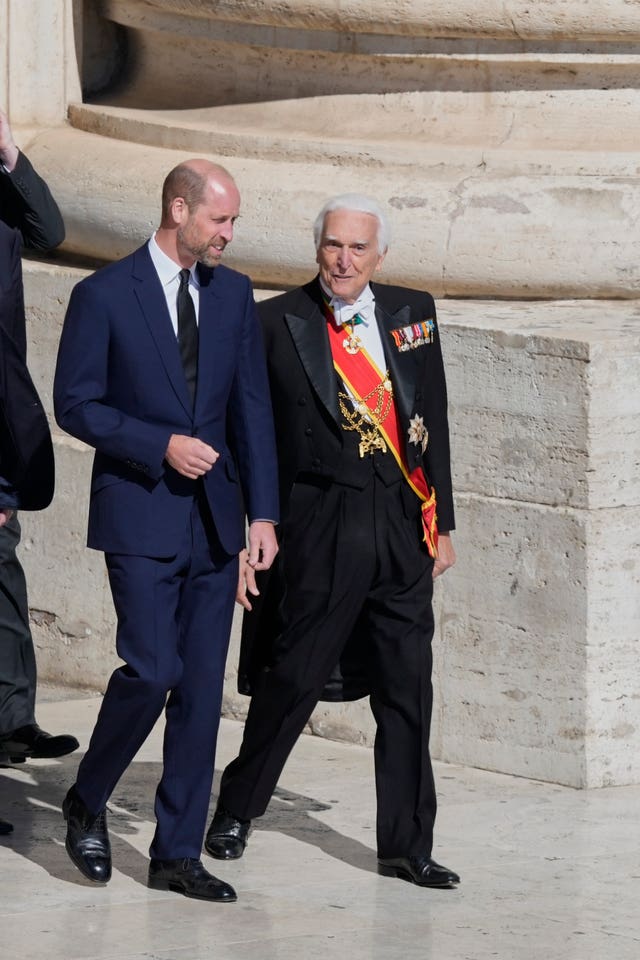
Crowds at the funeral applauded as the pontiff’s coffin was brought back into St Peter’s Basilica after the open-air mass.
A group of young women from Scotland told how they travelled to Rome for Pope Francis’s funeral to “celebrate a great leader”.
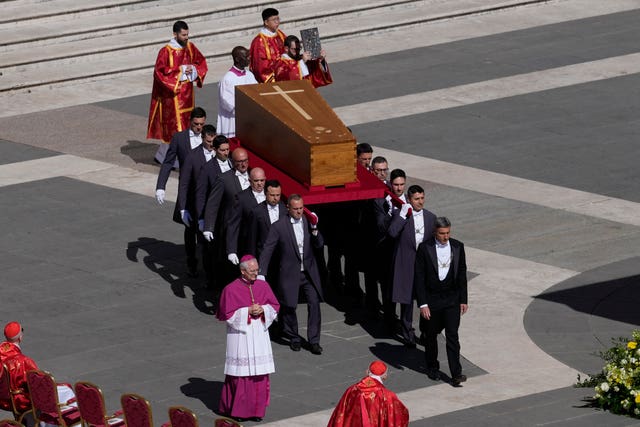
Claire, Erin and Maria – from Kirkintilloch, near Glasgow – spoke to the BBC as crowds gathered for the funeral.
Claire said: “We were able to come here, we wanted to come here.
“Although it’s a sad day for the Catholic Church, it’s a day where we can celebrate a great leader, so we want to be part of it.”
Erin said: “Although it’s sad, it’s great to be able to celebrate how great a pope he was.”
She added: “As a young person, I think he really spoke to the youth.”
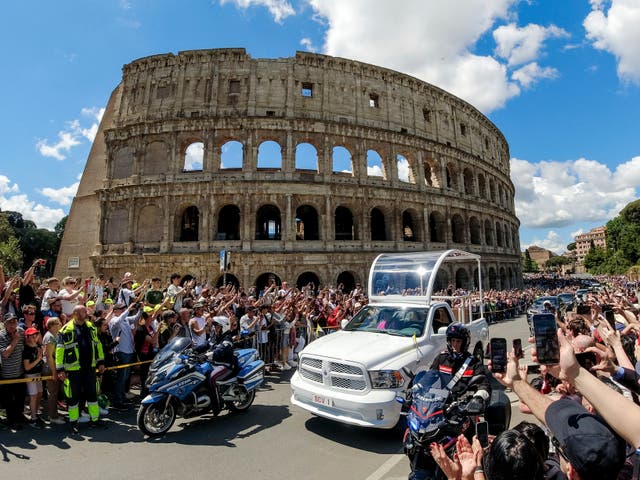
People gathered on the streets of Rome to pay respects to Pope Francis as his coffin was transported through the city after the funeral.
The casket was driven through the Italian capital in a white vehicle, similar to the open-top pope mobile.
The Pope’s coffin was received by a “group of poor and needy people” as it arrived at St Mary Major church where he will be buried in private.
The Vatican previously announced that people will be able to visit Francis’s tomb from Sunday morning.
Some 250,000 mourners paid their respects to Pope Francis over a three-day lying-in-state, which ran overnight from Wednesday due to high demand.

The final mourners had a chance to see the Pope close up in the grand surrounds of St Peter’s Basilica, before the coffin was closed in private on Friday evening.
While Saturday is the first of nine official days of mourning, speculation regarding the next pope is likely to begin soon after the funeral.
Conclave, the secret meeting of cardinals to elect Francis’s successor, is thought likely to begin on May 5.
Irish-born Cardinal Kevin Farrell – the camerlengo or senior Vatican official – has been responsible for carrying out the administrative and financial duties of the Holy See until a new pope takes over.
He had the role of announcing the Pope’s death on Easter Monday, co-ordinating meetings with the cardinals before conclave and ensuring the Sistine Chapel is ready to accommodate them when that process begins in the coming weeks.
The sign of a new pope having been elected will be the emergence of white smoke from a chimney of the Sistine Chapel while, soon after, an announcement in Latin of “Habemus Papam” – meaning “we have a pope” – is made alongside the chosen pontiff’s appearance on the balcony of St Peter’s Basilica.





